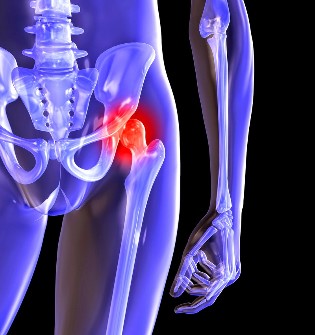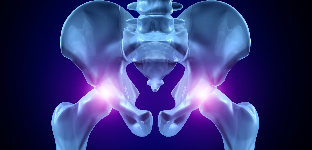Osteoarthritis of the hip joint degenerative disease, characterized by destruction of the transparent cartilage. The disease develops gradually, associated with pain and reduced range of motion. Without medical treatment in the early stages of osteoarthritis several years later, there is atrophy of the thigh muscles. The injured limb is shortened, and the fusion of the joint space lead to partial or complete paralysis of the hip joint. Cause of pathology become previous trauma, curvature of the spine, systemic diseases of the musculoskeletal system.

Osteoarthritis is usually diagnosed in patients middle-aged and older people. The diagnosis put on the basis of results of instrumental studies, — x-ray, MRI, CT, arthroscopy. Treatment of disease 1 and 2 the severity of a conservative. Upon detection of ankylosis or ineffectiveness of drug therapy, surgical operation (arthrodesis, arthroplasty).
The mechanism of development of pathology
The hip joint consists of two bones — the iliac and femoral. The lower part of hip bone presents her body, which participates in plexus with the femur, forming the upper part of the acetabulum. During the movement in place of the glenoid fossa and the femoral head moves freely. This "hinge" device, the hip joint allows him to bend, stretch, rotate, promote diversion, so that the pelvis. Smooth gliding articular structures provides a smooth, flexible, transparent cartilage lining the socket and the femoral head. Its main function is the redistribution of load is being driven, to prevent the rapid deterioration of the bone tissue.

Under the influence of external or internal factors disturbed the food chain of the cartilage. He's not wrong — nutrients to tissues supplies the synovial fluid. If the osteoarthritis, that it thickens and becomes viscous. A shortage of nutrients provoked the drying of the surface of the transparent cartilage. It is covered with cracks, which leads to a constant micro-trauma to the tissues of flexion or extension of the hip joint. Cartilage become thinner, lose their cushioning properties. To "adapt" to the increase of pressure, the bones are deformed. And against the background of the deterioration of metabolism in the tissues of the progress of the destructive-degenerative changes.
Causes and predisposing factors
Idiopathic or primary osteoarthritis develops without any reason. It is believed that the destruction of the cartilage occurs due to the natural aging of the body, slowing down regenerative processes, the breakdown of collagen and other compounds are necessary for the proper reform of the structures of the hip joint. Secondary osteoarthritis occurs on a background already present in the organism a morbid condition. The most common causes of secondary disease are:
- previous damage — damage to the tendon unit, muscle tears, their complete separation from the bone base fractures, dislocations;
- developmental disorders of the joints, congenital dysplasia of disorders;
- autoimmune disease — rheumatoid, reactive, psoriatic arthritis, systemic lupus erythematosus;
- nonspecific inflammatory diseases, for example suppurative arthritis;
- specific infections — gonorrhea, syphilis, brucellosis, anaplasmosis, trichomoniasis, tuberculosis, osteomyelitis, encephalitis;
- disruption of the functioning of the endocrine system;
- degenerative disease — osteochondropathy of the femoral head;
- hypermobility of the joints, because the production of the "super bet" collagen, which trigger their excessive movement, weakness of the ligaments.
Because cause the development of osteoarthritis may be hemarthrosis (bleeding in the cavity of the hip joint), precipitating factors are a violation of hematopoiesis. The conditions of the disease are being overweight, excessive exercise, lack of exercise. Its development leads to the wrong organisation of trainings, a deficiency in the diet products with a high content of minerals, fat and water soluble vitamins. After surgery osteoarthritis occurs many years after surgical intervention, especially if it was involved in cutting large amount of tissue. Osteoarthritis of the hip joint can transfer by inheritance. But the presence of certain congenital features (violation of metabolism, structure, skeleton), the probability of its development is significantly increased.
Symptoms
The leading symptoms of osteoarthritis of the hip joint pain when walking the thigh, the knee joint. A person suffering from stiffness in the limbs, stiffness, especially in the morning. Stabilize the joint, the patient begins to limp, his gait changed. Over time, muscular atrophy and deformation of the joint of the limb is considerably shortened. Another characteristic feature of the pathology — limitation of hip abduction. For example, difficulties arise when trying to sit on a chair, legs apart to the sides.

Even "running" ARTHRITIS can be cured at home! Just remember times a day to lubricate it...
For osteoarthritis of the first degree characterized by periodic pain that occurs after intensive physical loads. They are located in the area of articulation and disappear after a long vacation.
Secondary osteoarthritis of the hip joints the pain intensity increases. The pain also occurs at rest, to expand in the hips and groin, worse when lifting weights or increasing physical activity. Address hip pain, a person begins with a barely noticeable limp. Marked limitation of motion of the joint, especially abduction and internal rotation of the hip.
Osteoarthritis in the third degree is characterized by constant severe pain. When driving is difficult, therefore, when walking a person will have to use a cane or crutches. Because of the weakness of the abductor muscles, the hip is the deviation of the pelvic bone in front of the plane. To compensate for the occurred shortening of the leg of the patient, when the movement is tilted towards the extremities. This provoking change of focus and increased stress on the joint. At this stage osteoarthritis develops strong ankylosis of the joints.
| Degree | Radiographic signs of |
| The first | The changes are expressed not sharply. The joints of the slits moderate, irregular cramped, there is not destroy the surface of the femur. The outer or inner edge of the acetabulum, was a little bony growths |
| Another | The height of the joint space is significantly reduced, because of its uneven seam. Bone head of the femur moves upward, deformed, expanded, its outline has become uneven. Osteophytes are formed on the surface of the inner and outer edges of the glenoid fossa |
| The third | There is a complete or partial fusion of the joint space. The head of the femur is strongly expanded. Several bone growths located on the surface of the acetabulum |
Diagnosis
When setting the diagnosis, the doctor considers the disease the clinical symptoms, anamnesis, the external examination of the patient and instrumental examinations. The most informative radiography. It allows assessing the state of the hip joint, it set the stage for its course, the degree of damage to cartilage tissues, and in some cases, the cause of development. If the cervico-diaphyseal node is increased, and the acetabulum is flattened and beveled, then with high probability it is possible to assume congenital dysplastic changes in the joints. In Perthes disease shows the broken form of the thigh bone. X-ray allows the identification and preparation of post-traumatic osteoarthritis, although the lack of previous illness, injury. Also, use other diagnostic methods:
- CT helps detect tumors in the edges of the plates of bone to form osteophytes;
- MRI is performed to assess the condition of the connective tissue structures and the extent of their involvement in the pathological process.
If necessary, the inner surface of the joint is examined with the help of arthroscopic instruments. The differential diagnosis is made to rule out osteoarthritis, lumbar-sacral or thoracic degenerative disc disease. Pain of osteoarthritis may masquerade as clinical symptoms of radicular syndrome is caused by compression or inflammation of the nerve. Leave a neurogenic pathology generally through a series of tests. Osteoarthritis of the hip joint necessarily differentials from the top to bursitis of the hip, ankylosing spondylitis, reactive arthritis. Leave the auto-immune diseases is carried out biochemical studies of blood and synovial fluid.
Surgery
When ineffectiveness of conservative treatment Il diagnosis of a complex pathology, the surgery is performed. Restore cartilage joints damaged by arthritis, no surgeries impossible, but with the right approach to treatment, in compliance with all doctor's orders, maintain a correct way of life, medical gymnastics, in regular courses of massage, vitamins and proper nutrition can stop the process of destruction and the destruction of the cartilage and hip joints.
































